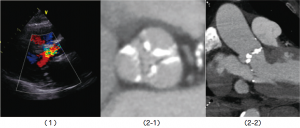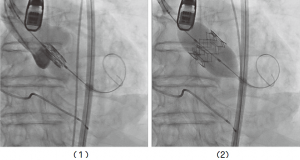キーワード: 循環器、生活習慣病、チーム医療、疫学
 高齢化や生活習慣病により、死に至る病気は大きく変化しているように見えます。しかし、直接の死因であるかを突き詰めると、「血流の異常」、すなわち「心臓血管死」が依然として多く、全死因の約30%を占めています。
高齢化や生活習慣病により、死に至る病気は大きく変化しているように見えます。しかし、直接の死因であるかを突き詰めると、「血流の異常」、すなわち「心臓血管死」が依然として多く、全死因の約30%を占めています。
血流は心臓から全身に張り巡らされていますから、これを突き詰めることは多くの疾患の根治・根絶に役立つはずです。本リサーチユニットは、「心臓血管死」とあらゆる側面から戦っています。
高度先進医療を核としたチーム医療の推進
本リサーチユニットには、循環器内科、心臓血管外科、小児内科循環器グループ、放射線科、臨床疫学等、およそ心臓血管を扱うすべての領域の医師が参加し、分野を超えて疾患の治療に向けた議論が交わされています。これにより、診療科の枠を超えた最適な治療法を提供するチーム医療が行われています。
たとえば大動脈弁狭窄症に対して施行される経カテーテル大動脈弁留置術(TAVI)、内科的な治療である不整脈の根治術、薬剤耐性高血圧治療に役立つ腎交感神経アブレーション術など、これまで複数の診療科の治療法にまたがっていた領域に心臓血管チームで対応することでより有効な治療法を提供することが可能となっています。

図1:大動脈弁狭窄症
(1)心エコー図(色が付いている部分は弁の不具合により血流に異常がある部分)
(2)CT 検査(弁の断面像と長軸像。弁に石灰化による異常がある)

図2:大動脈弁狭窄症に対する経カテーテル大動脈弁置換術(TAVI)
(1)生体弁を留置部位に挿入します。
(2)バルーンを膨らませ、生体弁を留置し、カテーテルを抜き取ります。
最新の研究成果が、リスクを下げ、イノベーションを生む
「心臓血管死」は、死因として戦後大きくその数が減少しています。これは、治療技術だけでなく、その背景となる高血圧症への理解や、減塩など、発症を予防する知識の啓蒙があったためです。一方、近年は従来からの高血圧を起点とした発症ではなく、高カロリー等生活形態の変化や先天的な要因の解明など、さらなる減少に向けたターゲットも明らかとなってきました。このためには、未病段階から先制攻撃をするべく、たとえば疫学的調査と、最新の基礎医学の成果を融合させた発症因子の解明などが求められており、本チームでも茨城県などと協力して研究を進めています。
さらに新しい治療法の開発は、これらを支える機器や薬剤の開発を生み出すことから、医工連携によるイノベーションの出発点になることも期待されています。
社会への貢献・実績
- 本ユニットに関連する研究成果を国内外の論文誌、学会等と通じて積極的に発信
- 大学関係者や市民向けに著名な研究者を招く等によるセミナーを開催
取材:平成27年8月18日
“Protect blood vessels!” -Multidisciplinary team approach to cardiovascular diseases -
Unit name: Cardiovascular Research Unit
Key words: circulatory organ, lifestyle-related disease, team medicine, epidemiology
 Due to aging and lifestyle-related diseases, fatal diseases appear to be changing. However, concerning direct death causes, “blood flow abnormalities”, i.e., “cardiovascular deaths” still account for about 30% of all death causes.
Due to aging and lifestyle-related diseases, fatal diseases appear to be changing. However, concerning direct death causes, “blood flow abnormalities”, i.e., “cardiovascular deaths” still account for about 30% of all death causes.
Since the heart pumps blood through the entire body, the thorough investigation of blood flow is useful for the radical cure/eradication of many diseases. This research unit fights against “cardiovascular deaths” from all aspects.
Promotion of team medicine with highly advanced medical treatment as a core
This unit consists of physicians in all fields dealing with cardiac blood vessels, such as the Departments of Cardiology and Cardiovascular Surgery, Pediatric Cardiology Group, and Departments of Radiology and Clinical Epidemiology. Discussions are held for multidisciplinary treatment. Thus, our team medicine provides optimal treatment methods beyond individual departments.
For diseases that have required treatment in multiple departments, our cardiovascular team can provide more effective treatment methods such as transcatheter aortic valve implantation (TAVI) for aortic valve stenosis, radical medical treatment for arrhythmia, and renal sympathetic nerve ablation that is useful for drug-resistant hypertension.

Fig. 1: A case of aortic valve stenosis (1) Echocardiogram (The colored part indicates abnormal blood flow due to valve stenosis.) (2) CT scan (Cross-sectional and longitudinal images of the valve showing abnormality due to calcification.)

Fig. 2: TAVI for aortic valve stenosis (1) A biological valve is inserted into the placement site. (2) The balloon is expanded, the biological valve is placed, and the catheter is removed.
Results of the latest research reduce risks and lead to the creation of innovations
The number of “cardiovascular deaths” as the cause of death has markedly decreased after World War II. This is because of not only advances in treatment techniques but also the understanding of hypertension as a background factor and educational activities concerning preventive measures such as a reduction in salt intake. In recent years, for a further reduction in cardiovascular deaths, treatment targets as background factors other than hypertension, such as high calorie intake due to lifestyle changes and congenital factors, have also been clarified. Therefore, a pre-emptive attack should be made in the pre-disease stage. For example, factors associated with onset should be clarified based on both the results of epidemiological surveys and basic medical research. To this end, our team has performed research in cooperation with Ibaraki Prefecture.
The development of novel treatment methods leads to the development of apparatuses and drugs necessary for these methods, which can be a starting point of innovations through medicine-engineering collaboration.
Social contributions and achievements
- The results of research associated with this unit have actively been reported in domestic and overseas academic journals and conferences.
- Seminars with invited prominent researchers have been held for people related to our university and citizens.
Interviewed on August 18, 2015
